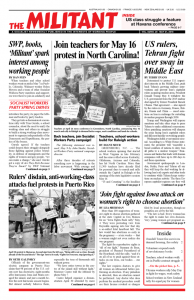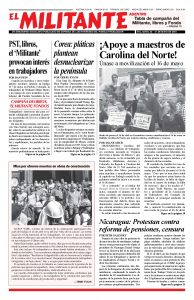The article below corrects the initial weeks of Militant coverage of the large working-class protests that began in Mashhad, Iran, on Dec. 28 and swept some 90 cities and towns across the length and breadth of that country in early January. The article is based on reports by Socialist Workers Party National Secretary Jack Barnes discussed and adopted by the party’s National Committee.
The Militant, echoing bourgeois media coverage, inaccurately presented those actions as largely a response to economic grievances and Tehran’s cutbacks of subsidies and social expenditures. This was captured by headlines in the Jan. 15 and Jan. 22 issues: “Economic Crisis Behind Protests in Iran Cities” and “Working-Class Discontent Continues to Spread in Iran.” While improved coverage appeared in subsequent articles, the failure to publish an explicit correction denies readers the facts and analysis they need to understand the political roots of these events and their significance in the ongoing class struggle and wars in the Middle East and today’s world.
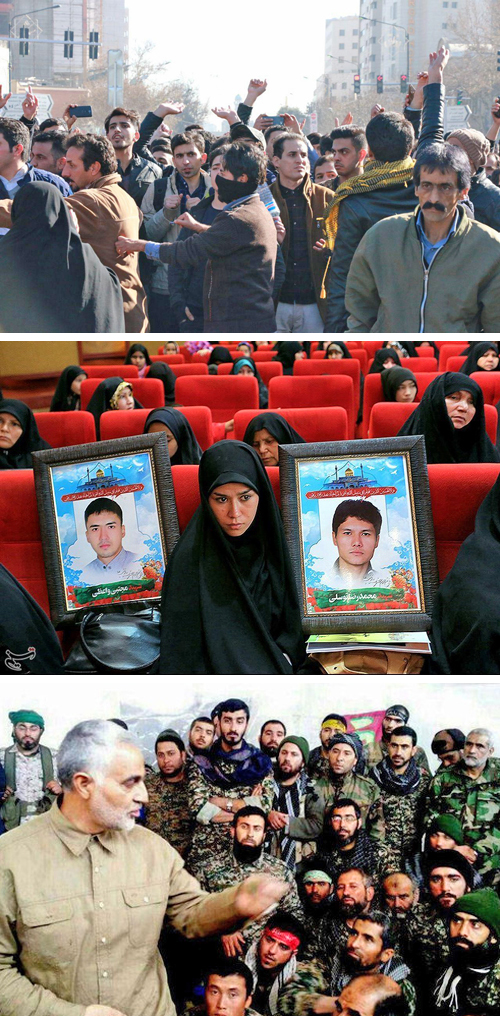
BY STEVE CLARK
A political crisis is shaking Iran, as the bourgeois clerical regime presses workers and farmers there, as well as working people from Afghanistan,
Pakistan, Iraq, Lebanon and elsewhere, into military service across the Middle East. The Iranian bourgeoisie’s aim is to increase its regional power and influence by force of arms, extending beyond Iran’s borders the nearly four-decade-long political, cleric-dominated counterrevolution that pushed back the workers, farmers, women and oppressed nationalities who carried out the historic Iranian Revolution of 1979.
That upheaval was a deep-going, modern, popular social revolution in city and countryside, not a religious jihad as it is falsely portrayed by bourgeois voices. The revolution reverberated across the Middle East and the world.
Two centuries of experience have taught politically conscious workers that neither popular revolutions, nor resistance by working people to the consequences of defeated revolutions, are fueled primarily by “economic discontent.” Much deeper social and political questions of class, sex, sect and race push working people into action in our tens and hundreds of thousands (and, at decisive points, in our millions). Above all, it is the class and social inequities and indignities of capitalist exploitation and oppression that erode the moral legitimacy of the rulers and their state. And nothing propels mounting resistance more than the privileged classes’ military adventures and wars, as the rulers’ nationalist and religious rationalizations (Persian and Shiite, in the case of Iran) begin dissolving in blood.
“We were charged with conspiracy to overthrow the government by armed revolution,” wrote Farrell Dobbs in Teamster Bureaucracy about the indictments handed down by Washington in July 1941 against 29 leaders of the Socialist Workers Party and Local 544-CIO. The true goal of those frame-up charges was to undercut the political campaign led by Minneapolis Teamsters to organize working-class and union opposition to the U.S. rulers’ imperialist aims in World War II, Dobbs wrote, but “the word war appeared nowhere in the federal indictment … because it would have been unpopular at that juncture to persecute us as opponents of imperialist foreign policy.”
The cover of the new edition of Teamster Bureaucracy — the final of Dobbs’ four-volume account of the Minneapolis-based class-struggle leadership that transformed the U.S. labor movement during the Great Depression — reproduces the banner headline from the Militant in June 1941: “Why We Have Been Indicted: SOCIALIST WORKERS PARTY IS THE ANTI-WAR PARTY.”
It’s not just in imperialist countries such as the United States that an accelerated drive toward militarization and war becomes inevitable at a certain stage for the propertied classes. In Iran today, faced with rising unrest among working people and the oppressed, the only way for the capitalist rulers to try to defend and preserve their counterrevolutionary regime at home is to continue extending political reaction throughout Iraq, Syria, Lebanon, Yemen and divided Kurdistan. The bourgeois clerical regime rationalizes its bloody course under the banner of rectifying the historical oppression of Shiites in Iraq and across the Arab world, a divide-and-rule oppression manipulated and amplified by more than a century of French, British and U.S. imperialist domination.
From left to right in bourgeois politics in the United States and across the imperialist world, however, this political counterrevolution in Iran is presented as if it were the 1979 revolution itself; the two are identified as the same thing. Those the capitalist media hold up as “leaders of the revolution” are, in fact, leaders of the counterrevolution — a “through-the-looking-glass” vindication of false claims by these bourgeois Iranian figures and their political apologists.
Women and revolution in Iran
An article in the Feb. 4 issue of the New York Times, for example, was headlined: “Compulsory Veils? Half of Iranians Say ‘No’ to Pillar of Revolution.” Thomas Erdbrink, Tehran bureau chief for America’s “newspaper of record,” reported the release of an Iranian government survey showing widespread opposition to women “being forced to wear the veil, a symbol of Iran’s revolution” [emphasis added]. The article describes recent protests in Iran against obligatory head cover and adds that the “law regarding the scarf has been enforced since the 1979 Islamic Revolution.”
But the compulsory hijab — a headscarf covering the hair and neck — is not “a symbol of Iran’s revolution.” To the contrary.
Yes, most working people and youth who made the 1979 revolution opposed the royal decree imposed in the 1930s by the imperialist-backed shah of Iran, in the name of capitalist “modernization,” denying women the right to decide for themselves how to dress in public. The shah’s cops who ripped veils off women’s heads and faces were the same ones who dragged workers and youth to torture centers and prisons across Iran.
But in March 1979, when Ayatollah Ruhollah Khomeini declared that female employees of government ministries must not go to work “naked” but be “clothed according to Islamic standards,” students, workers and other women and men took to the streets by the tens of thousands across Iran — the largest International Women’s Day outpouring anywhere in the world that year. Demonstrators fought off organized thugs and forced Khomeini to back down.
What’s more, the government’s labor ministry later that month announced that women in factories and other workplaces were entitled to equal rights on the job, including the right to participate in elections to the workers councils (shoras) and to hold office.
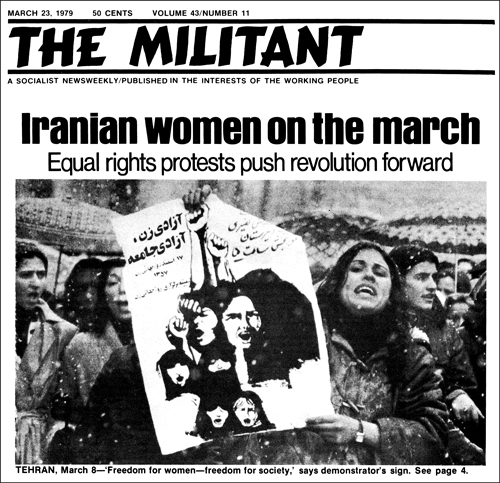
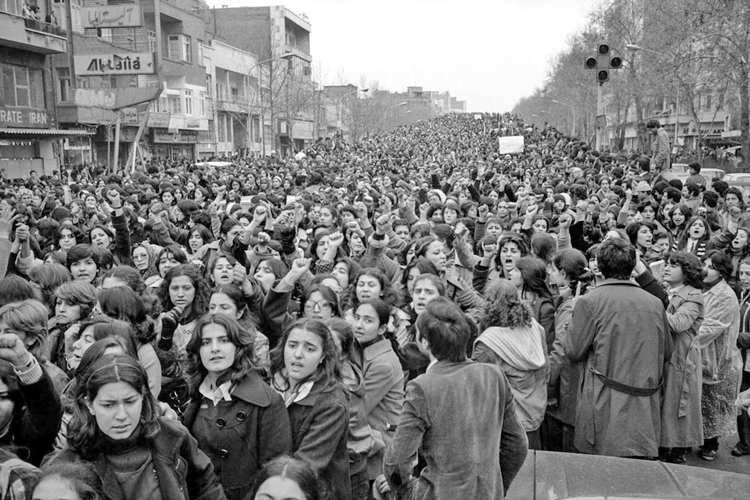
It was not until mid-1983, as the counterrevolution consolidated its stranglehold, that the Iranian regime was finally able to impose  legislation barring women from “appear[ing] in public without religious hijab.” Over the next couple of years, the government increasingly unleashed special “anti-vice” squads to confront women on the streets and compel observance.
legislation barring women from “appear[ing] in public without religious hijab.” Over the next couple of years, the government increasingly unleashed special “anti-vice” squads to confront women on the streets and compel observance.
The acts of public defiance of this law since December, as well as longer-term resistance to enforcement the regime has met in recent years, are a manifestation of mounting consciousness about and struggles against the indignities, abuse and discrimination faced by women the world over. Far from being a hobby horse of wealthy and middle-class women in Iran (as often caricatured in the bourgeois press), demands for women’s rights — in word and deed — were central to struggles by millions, including working women and men, during the 1979 revolution. They are among the revolution’s eroded conquests. Prospects for defense and advance of such gains have been renewed by the recent working-class protests and others to come.
There will be no end to Tehran’s counterrevolutionary wars, expansionism and reactionary social policies without an end to the counterrevolutionary bourgeois clerical regime. The factional divisions within the bourgeois government and ruling layers are creating greater political space for workers and farmers, who acted on these openings in late December and early January.
Fake ‘axis of resistance’
“Today, throughout the region, Islam and the Islamic Republic of Iran are greater than ever,” said President Hassan Rouhani, the leading figure among those labeled “reformists” today, in an October 2017 speech in Iran.
“Can anyone take any action in Iraq, Syria, Lebanon, North Africa and the Persian Gulf without considering Iran’s viewpoint?” — Iran’s “viewpoint” is hardly the issue! Rouhani continued: “This is due to the nation’s consciousness and unity, and the vigilance of the Leader,” that is, of Ayatollah Ali Khamenei.
The President Rouhani who signed the 2015 nuclear pact with Washington (along with London, Moscow, Paris, Beijing and Berlin) is the same President Rouhani who has presided over the military operations in Iraq, Syria, Lebanon and elsewhere by Iran’s Quds Force (the “foreign legion” of its Islamic Revolutionary Guard Corps), along with other Tehran-backed, Shiite-based militias. Deploying forces from what Iran’s bourgeois clerical regime cynically calls the “axis of resistance,” it has opened a corridor of military power, political influence and economic exploitation all the way to the Mediterranean Sea and Turkish border, as well as in Yemen and pockets elsewhere in the Middle East.
The Iraqi regime is the first Shiite-dominated Arab government in history, with large Sunni Arab, Kurdish, Turkic and other non-Shiite minority populations. Baghdad is dependent for its military defense on Revolutionary Guard-organized Shiite militias of Iraqi, Iranian, Lebanese, Afghan and other combatants, sometimes with Iranian or Hezbollah officers.
A similar situation exists in Syria, where such forces stepped into the vacuum created by Bashar al-Assad’s collapsing army and — with Russian air, naval, and some ground support — salvaged that tyrannical regime at a horrific toll of more than 10 million Syrian toilers displaced, killed or maimed.
Hezbollah, after taking blows at the hands of Israeli forces in the 2006 war, has bolstered its position politically and militarily vis-à-vis Sunni- and Christian-led bourgeois forces in Lebanon.
Rival ruling classes throughout the region know that, despite the 2015 agreement, Tehran is close to being able to produce nuclear weapons and delivery systems. Such arms, however, would provide no defense for Iran against military threats from U.S. imperialism and other nuclear powers, nor any relief from the inhumane and unconscionable sanctions Washington and other imperialist governments have imposed on the Iranian people. To the contrary, weapons of mass destruction would merely provide a rationalization for the Saudi Arabian and other regimes in the region to enter the nuclear arms race, as well as for the Israeli government to maintain and bolster its existing nuclear arsenal.
The Socialist Workers Party demands Washington’s immediate unilateral nuclear disarmament. We call on the eight other regimes in the world that currently have these catastrophic weapons to get rid of them, and we oppose their development and deployment by any government. In this regard, as in many others, the SWP points to the proletarian internationalist example set by the leadership of Cuba’s socialist revolution.
Counterrevolution takes hold
In 1980 workers and small farmers volunteered by the hundreds of thousands to fight the invading forces of the Iraqi regime of Saddam Hussein, tacitly backed, armed and financed by Washington, Paris and other imperialist powers. Working people in Iran recognized that invasion as an attempt to deal a deathblow to their revolution. Their mobilizations gave a brief second wind to popular resistance to the counterrevolution at home. These bourgeois clerical forces targeted political rights; workers’ shoras (councils) in the factories, refineries and other workplaces; farmers’ demands for land; the rights of Kurds and other oppressed nationalities; and women’s rights.
Members of the communist party in Iran at that time — the Socialist Workers Party (HKS), later renamed the Workers Unity Party (HVK) — were in the thick of the revolutionary class struggle. They were workers in factories, refineries and other industrial workplaces, as well as volunteer soldiers combating the Iraqi invasion. Many of that party’s cadres and leaders had been recruited and trained by the Socialist Workers Party in the United States while studying or working here during the tyrannical reign of the shah. Other workers, soldiers and students were won to the party in Iran during the opening years of the revolution.
The HVK advocated “extension and unification of factory shoras”; “land distribution under the control of peasant shoras”; “the right of self-determination [and] autonomy” of Kurds and other oppressed nationalities; and equal rights for women, including “the right to work and equal pay for equal work,” “child care,” and “against compulsory veiling and any kind of discrimination and humiliation of women.” The HVK demanded full political liberties and the release of “all anti-imperialist and working-class political prisoners,” and called for “the extension and unification of workers, peasants, soldiers and Pasdaran [Revolution Guard] shoras. For a workers and peasants government.”
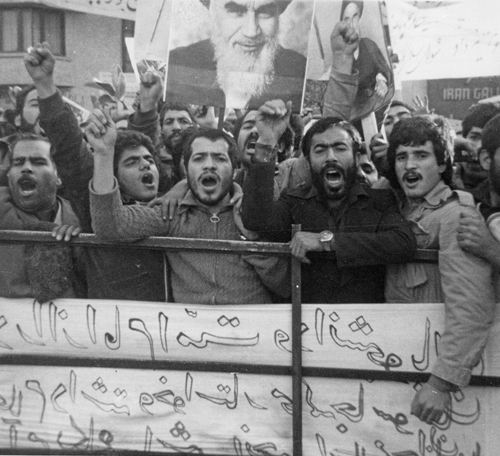
In the United States and around the world, it was only in the pages of the Militant (and its sister international news magazine, Intercontinental Press) that working people could find accurate, firsthand accounts of the Iranian Revolution and efforts by working people and the oppressed to defend and advance it in face of assaults by U.S. imperialism, by hostile regimes in the region, and by bourgeois forces in Iran itself. Members of Socialist Workers Party branches and trade union fractions in the United States took the truth about the revolution and our defense of it to co-workers in factories, mines and other workplaces, as well as into the streets.
By the early 1980s, however, the bourgeoisie and Islamic Republic were employing increasingly brutal repression to turn back and defeat struggles by working people and the oppressed, consolidating the rulers’ counterrevolutionary clutch at home.
After Iranian military forces pushed Saddam Hussein’s invading army back across the border in mid-1982, Tehran sent its own troops into Iraq in large numbers. Whatever defensive purpose this initially served, the Tehran regime over the next several years sent wave after wave of teenage and other young Iranian working people to needless slaughter as it assaulted population centers in Iraq. During that same period, the Sunni-based bourgeois rulers in Baghdad were conducting poison-gas attacks and other atrocities against the Kurds (the murderous “Anfal” campaign commanded by Saddam’s cousin, “Chemical Ali”) and against the majority Shiite population within Iraq’s own borders.
By the end of 1982, a combination of official and government-sponsored thug terror made it impossible for communists to any longer carry out political activity in Iran. The record of the proletarian internationalist course and unbroken continuity of that communist party, however, exists to be studied by new generations and put into practice as conditions permit. A good starting point can be found in issue no. 7 of New International, which includes “The Opening Guns of World War III” by Jack Barnes and “Communism, the Working Class, and the Anti-Imperialist Struggle: Lessons from the Iran-Iraq War,” two HVK documents with an introduction by Samad Sharif.
Workers oppose Tehran’s wars
In stark contrast to the voluntary mobilizations by Iranian toilers to the battlefront in 1980, in recent years most veterans of the Iran-Iraq war and their children and grandchildren have urged young men not to sign up for Quds Force operations in Iraq and Syria. The Revolutionary Guard have had to rely on financial inducements to recruit and hold the forces they need for those wars. Payment sometimes as high as $600-$700 a month is well above the norm for workers and farmers in Iran, and Afghan and other refugees living in Iran are promised citizenship for themselves and their families if they serve.
Mounting war deaths and disfigurement over the past half decade, however, have taken a more bitter toll than can be tallied in Iranian rials. The carnage falls with class-divided disproportion, shattering disproportion, not on university districts or professional and middle-class neighborhoods, but on workers’ quarters in major cities and smaller towns and farming villages across Iran. That is where the December and January protests were centered, unlike the 2009 mobilizations protesting the results of that year’s presidential election.
Iran’s bourgeois government and rulers initially said little publicly about their wars in Iraq, Syria and Yemen, but that became unsustainable as body bags returned in larger numbers to working-class and farm families. The regime then sought to encourage monuments and memorials to the dead and wounded in workers’ districts and towns, hoping to use the “martyrs” to rekindle patriotism and mobilize popular support for their counterrevolutionary military operations. But as the recent protests showed, these ruling-class efforts backfired.
It is in light of these rising class tensions that divisions within the government and ruling layers have widened in recent years, including fractures within older factional alignments.
It’s only in recent years, for example, that the Shiite cleric Hassan Rouhani has been seen, or has presented himself, as a “reformist.” He was Ayatollah Khamenei’s hand-picked representative to Iran’s Supreme National Security Council for 16 years beginning in 1989. He is notorious for having led the brutal suppression of widespread student protests against repressive new press laws in 1999. Similarly, while Rouhani supported statements by Tehran police authorities in late 2017 that they would no longer arrest women for “bad hijab” — “One cannot force one’s lifestyle on the future generations,” the president said — he was directly involved in introducing the 1983 legislation imposing compulsory clothing.
These rifts in Iran’s bourgeoisie are not cosmetic. They’re not a “hard cop/soft cop” charade to hoodwink imperialist governments and Iran’s rival bourgeois regimes in the region. They’re real and volatile, rooted in Iran’s current social relations.
When President Rouhani in December 2017 made the Islamic Republic’s budget public for the first time, his goal was to advance factional political ends against bourgeois opponents in the leadership of the Revolutionary Guard. It’s as if Rouhani were saying, “I don’t even control most of the government budget” — demagogically hoping to deflect fire from his administration for cuts in needed subsidies, social payments, wages, and earthquake relief.
In releasing the budget, however, Rouhani ended up fueling the protests, since it revealed huge government expenditures on religious institutions linked to the Revolutionary Guard, which has been central to recruiting and organizing the militias fighting in Iraq and Syria.
Meanwhile, as recently as mid-2017, Rouhani boasted that Iran’s military budget has more than doubled since his election in 2013. Those war expenditures are set to increase this year by another 90 percent over 2017.
What’s more, once workers’ protests wound down in early January, Supreme Leader Ayatollah Khamenei announced that he had approved withdrawing an additional $2.5 billion from the National Development Fund of the Islamic Republic of Iran — which supposedly sets aside oil and gas revenues to meet infrastructure and welfare needs — to boost Iran’s war chest (already some $13 billion in 2017).
Why? Because no section of the Iranian bourgeoisie or government has any intention of pulling back from deployments and military operations in Iraq, Syria, Lebanon or Yemen.
Smearing workers as ‘garbage’
In early January, when a well-known Islamic cleric smeared working-class protesters as “garbage” during Friday prayers in Tehran, Rouhani sharply rebuked him for those remarks on state television. “We cannot call everybody who takes to the streets dirt and dust, cow, sheep or trash,” Rouhani said. “What manner of talking is this? Why do we insult? Why do we treat our society impolitely?”
Rouhani’s public response was popular among working people in Iran, as well as among many students and layers of the middle classes. It strengthened his hand against the Revolutionary Guard hierarchy.
The president is also acting on behalf of influential capitalist families by demanding that the Revolutionary Guard divest itself of major assets in Iran’s construction industry, oil and gas companies, banking and insurance, telecommunications — as well as the country’s thriving black market.
As working people take advantage of conflicts among these dominant factions in the government to open political space, other bourgeois-oriented currents are seeking to put their foot in the door as well. Already former Iranian President Mahmoud Ahmadinejad — barred by the Supreme Leader early last year from again running for president, and then blamed by Khamenei for the recent protests — is beating the drums of “economic discontent” in Iran. Ahmadinejad’s base, separate either from Rouhani’s “reformist” current or the Revolutionary Guard, is concentrated among the petty bourgeoisie and layers of working people in smaller cities and rural areas where many of the recent mobilizations took place.
The Stalinist Tudeh Party leadership, banned and harshly repressed during the height of the counterrevolution in the 1980s, issued three statements from exile between late December and early January. Focusing on the “economic bankruptcy” and “corruption” of the government, the Stalinist misleaders uttered not a word about Tehran’s wars and military adventures, since they share the regime’s support for Assad in Syria, its opposition to Kurdish national aspirations and its Persian nationalism.
In line with their Popular Frontist, procapitalist course, Tudeh leaders called on “progressive and freedom-loving forces” to “increase their presence in the protest movement”; to avoid “divisive slogans”; “to wage a joint and organized struggle of all social layers”; and “to establish the rule of the people,” “a national, popular, and democratic republic.” In short, to replace the Islamic Republic with another capitalist government based on opposition currents, in Iran and in exile, within the officer corps (of Iran’s standing army, not the Islamic Revolutionary Guard Corps), propertied families and their middle-class political representatives.
Shifts in Saudi Arabia
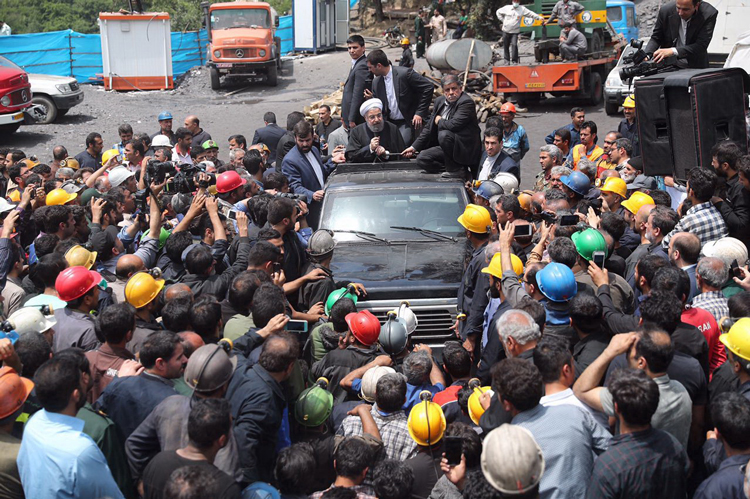
In face of the shifting relationship of class forces in the Gulf region in recent years, an increasingly dominant wing of Saudi Arabia’s capitalist rulers (a bourgeoisie forged over the past century from an extended tribal-based family) has recognized that it is being bested in its regional rivalry with Tehran.
In response, a decisive section of the Saudi regime, headed by Crown Prince Mohammed bin Salman, has decided they must sharply reverse engines on many fronts — and they are doing so. These include:
- efforts to accelerate industrial development and trade, instead of ongoing reliance on oil rents;
- steps to stem the drain on capital accumulation from subsidies to the sprawling, privileged ruling family;
- moves to halt the regime’s deference (in reaction to the 1979 jihadist assault on the Grand Mosque) to the Islamist Wahhabi Sunni hierarchy by bringing to heel the “religious police,” secularizing school curriculum and relaxing oppressive social and cultural norms for women in employment, driving, sports and entertainment; and
- mending the blowback for the Saudi regime from their collusion with U.S. imperialism in the 1980s to organize, finance, and train Islamist military squads in Afghanistan, which came a cropper for both Washington and Riyadh with the Sept. 11, 2001, terrorist assaults.
The Saudi rulers are now pressing this course, with open support from Washington and thinly veiled backing from the Israeli ruling class and government. Riyadh has now released most of the hundreds of wealthy Saudis arrested in November 2017, after reaching financial “settlements” with them netting the government some $106 billion for its capitalist modernization projects. The regime plans to raise another $100 billion in 2018 by placing for sale on world stock markets 5 percent of the giant Saudi oil and natural gas company, Aramco.
In late January, Israeli Prime Minister Benjamin Netanyahu traveled to Russia to inform President Vladimir Putin that the Israeli government will not back off from its determination that Tehran must neither establish a permanent military presence in Syria, nor collaborate with Hezbollah to turn Lebanon into a base for the manufacture and launching of missiles targeting Israel. The Israel Defense Forces report that in recent years they’ve conducted airstrikes and missile attacks on more than 100 Hezbollah convoys and other targets in Syria, and will continue doing so whenever Tehran-organized forces are deployed anywhere near Israel’s borders.
Way forward for working people
The programmatic and strategic course of the Socialist Workers Party in response to the tumultuous and shifting political situation in Iran and across the Gulf region is presented in the closing paragraphs of the Dec. 11, 2017, SWP statement, “For Recognition of a Palestinian State and of Israel”:
“In opposition to Washington, to bourgeois governments and political organizations across the Middle East, and to the middle class left here in the United States, the Socialist Workers Party has a different starting point: the class interests and solidarity of workers and toiling farmers across the Middle East — be they Palestinian, Jewish, Arab, Kurdish, Turkish, Persian or otherwise, and whatever their religious or other beliefs — as well as working people in the United States and around the world.
“We are for whatever helps working people organize and act together to advance our demands and struggles against the capitalist governments and ruling classes that exploit and oppress us and their petty bourgeois political servants and media apologists.
“We are for whatever renews our class solidarity and self-confidence, advancing us along a revolutionary course toward a united struggle for workers power.
“This is the proletarian internationalist course of action, part of our communist program, that members and supporters of the Socialist Workers Party are discussing with workers as we campaign door to door in their neighborhoods, with co-workers on the job and their friends and family members, and with those we join in protests against Washington’s anti-working-class policies at home and abroad.”
Click here to download PDF
